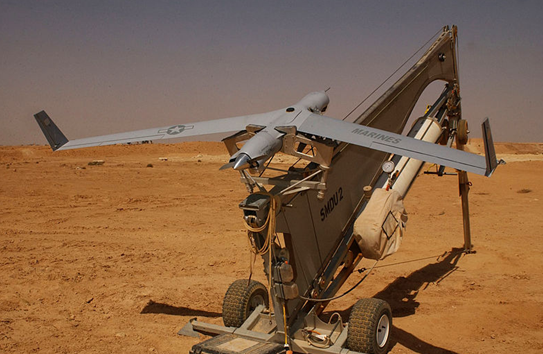

The Boeing Insitu ScanEagle is a small, low-cost, long-endurance unmanned aerial vehicle (UAV) built by Insitu, a subsidiary of Boeing. The ScanEagle was designed by Insitu based on the Insitu SeaScan, a commercial UAV that helped fishermen look for fish. The ScanEagle continues to be upgraded with improved technology and reliability.
Design and development
ScanEagle is a descendant of another Insitu UAV, SeaScan, which was conceived of as a remote sensor for collecting weather data as well as helping commercial fishermen locate and track schools of tuna. ScanEagle emerged as the result of a strategic alliance between Boeing and Insitu. The resulting technology has been successful as a portable Unmanned Aerial System (UAS) for autonomous surveillance in the battlefield, and has been deployed since August 2004 in the Iraq War.
ScanEagle carries a stabilized electro-optical and/or infrared camera on a lightweight inertial stabilized turret system integrated with communications range over 62 miles (100 km), and flight endurance of 20+ hours. ScanEagle has a 10.2-foot (3.1 m) wingspan a length of 4.5 feet (1.4 m) and a mass of 44 pounds (20 kg) and can operate up to 80 knots (92 mph; 150 km/h), with an average cruising speed of 48 knots (55 mph; 89 km/h). Block D aircraft featured a higher-resolution camera, a custom-designed Mode Ctransponder and a new video system. A Block D aircraft, flying at Boeing's test range in Boardman, Oregonset a type endurance record of 22 hours, 8 minutes.
ScanEagle needs no airfield for deployment. Instead, it is launched using a pneumatic launcher, patented by Insitu, known as the "SuperWedge" launcher. It is recovered using the "Skyhook" retrieval system, which uses a hook on the end of the wingtip to catch a rope hanging from a 30-to-50-foot (9.1 to 15 m) pole. This is made possible by high-quality differential GPS units mounted on the top of the pole and UAV. The rope is attached to a shock cord to reduce stress on the airframe imposed by the abrupt stop.
Each ScanEagle system costs US$3.2 million (2006). A complete system comprises four air vehicles or AVs, a ground control station, remote video terminal, and the Skyhook launch and recovery system.
Improvements
On 18 March 2008, Boeing, with ImSAR and Insitu successfully flight-tested a ScanEagle with ImSAR's NanoSAR A radar mounted aboard. The ImSAR NanoSAR is the world's smallest Synthetic Aperture Radar, weighs 3.5 lb (1,590 g) and is 100 cubic inches (1.6 litres) in volume. It is designed to provide high quality real-time ground imaging through adverse weather conditions or other battlefield obscurants.
In 2009, Boeing and Insitu announced the NightEagle, a modified ScanEagle Block E with an infrared camera for night operations.
In August 2010, Boeing announced plans to control ScanEagles from control stations on E-3A AWACS aircraft and on the V-22.
In July 2011, a team of two ScanEagles and another UAV cooperated to search and navigate a mountain area autonomously.
Operational history
The ScanEagle entered service with the U.S. Navy in 2005. In addition to the United States military, the Australian Army also operates the ScanEagle UAV and the Canadian Government also leased the ScanEagle.
In April 2009, a ScanEagle launched by the U.S. Navy was used during the stand-off between the U.S. Navy and a lifeboat controlled by pirates holding Capt. Richard Phillips of the MV Maersk Alabama in the Indian Ocean after a failed hijack attempt.
Insitu announced that the ScanEagle had totaled 500,000 combat flight hours and over 56,000 sorties by July 2011.
In December 2012, Iran stated it had captured an American ScanEagle that allegedly violated its airspace over the Persian Gulf. Iran later stated it had also captured two other ScanEagles. The U.S. Navy stated that none of its ScanEagles were missing. Photo evidence of an ScanEagle in Iran showed no U.S. military markings. In August, 2013, CBC News reported that the Canadian Navy had lost a ScanEagle drone in June 2012. The Navy denied it was obtained by Iran. It was also reported that Iran is producing a copied version of the ScanEagle and has put that UAV into military service.
In late May 2013, the U.S. Coast Guard used a ScanEagle to seize over 1,000 lb of cocaine from a fast boat in the eastern Pacific. The ScanEagle was being deployed off the USCGC Bertholf (WMSL-750) during demonstrations to assess UAV use in the Coast Guard. The aircraft was able to maintain visual surveillance of the boat until a cutter was able to interdict the vessel, marking the first time a UAV deployed from a Coast Guard cutter participated in drug interdiction. The trials in May lasted two weeks with 90 flight hours completed. The Coast Guard hopes to begin purchases of unmanned aerial systems by FY 2016, with small UAVs deployed from its National Security Cutter fleet by the following year. Long-term goals are to use unmanned systems to augment their manned fleet, while UAVs on offshore patrol cutters would replace medium endurance cutters.
On 26 July 2013, the ScanEagle became one of the first unmanned aerial vehicles to be granted certification by the Federal Aviation Administration to fly in U.S. airspace for commercial purposes.
ScanEagles will be deployed to Alaska off a ship for ConocoPhillips to scout for icebergs and count whales, protecting drilling platforms and fulfilling environmental requirements. The ScanEagle can safely accomplish observation missions in hazardous Arctic locations, which is safer, cheaper, and more environmentally friendly than using manned aircraft. Commercial certification was the result of previous military certification and the Congressionally-mandated opening of airspace over much of Alaska to small UAVs. Only four ScanEagles were certified with strict requirements: only one aircraft of the type is allowed airborne at any one time, they cannot fly through clouds or icing conditions, and they cannot take off or land during certain gust and wind conditions. The certifications did not mention line-of-sight control.
Specifications
Data from USAF Scan Eagle fact sheet
General characteristics
•Crew: none on-board
•Length: 3.9 feet (1.19 meters) ()
•Wingspan: 10.2 feet (3.1 meters) ()
•Height: ()
•Loaded weight: 39.7 lbs (18 kilograms) ()
•Powerplant: 1 × 3W 2-stroke piston engine, 1.5 hp ()
Performance
•Maximum speed: 55-80 mph
•Endurance: 20 + hours
•Service ceiling: 16,000 feet above ground level (4,876 meters) ()
Avionics
High resolution, day/night camera and thermal imager



















